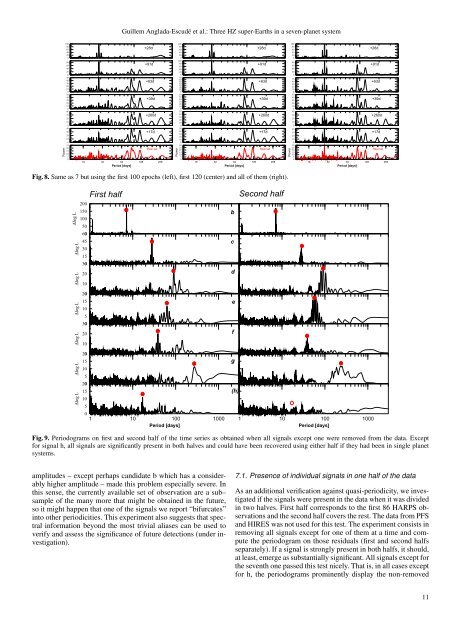A dynamically-packed planetary system around GJ 667C with ... - ESO
A dynamically-packed planetary system around GJ 667C with ... - ESO
A dynamically-packed planetary system around GJ 667C with ... - ESO
You also want an ePaper? Increase the reach of your titles
YUMPU automatically turns print PDFs into web optimized ePapers that Google loves.
Guillem Anglada-Escudé et al.: Three HZ super-Earths in a seven-planet <strong>system</strong><br />
Power<br />
100<br />
80<br />
60<br />
40<br />
20<br />
0<br />
80<br />
60<br />
40<br />
20<br />
0<br />
50<br />
40<br />
30<br />
20<br />
10<br />
0<br />
50<br />
40<br />
30<br />
20<br />
10<br />
0<br />
40<br />
30<br />
20<br />
10<br />
0<br />
40<br />
30<br />
20<br />
10<br />
0<br />
25<br />
20<br />
15<br />
10<br />
5<br />
0<br />
+28d<br />
+91d<br />
+63d<br />
+39d<br />
+260d<br />
+17d<br />
Real set<br />
16 32 64 128 256<br />
Period [days]<br />
Power<br />
100<br />
80<br />
60<br />
40<br />
20<br />
0<br />
100<br />
80<br />
60<br />
40<br />
20<br />
0<br />
70<br />
60<br />
50<br />
40<br />
30<br />
20<br />
10<br />
0<br />
60<br />
50<br />
40<br />
30<br />
20<br />
10<br />
0<br />
50<br />
40<br />
30<br />
20<br />
10<br />
0<br />
50<br />
40<br />
30<br />
20<br />
10<br />
0<br />
30<br />
25<br />
20<br />
15<br />
10<br />
5<br />
0<br />
+28d<br />
+91d<br />
+63d<br />
+39d<br />
+260d<br />
+17d<br />
Real set<br />
16 32 64 128 256<br />
Period [days]<br />
Power<br />
100<br />
80<br />
60<br />
40<br />
20<br />
0<br />
80<br />
60<br />
40<br />
20<br />
0<br />
50<br />
40<br />
30<br />
20<br />
10<br />
0<br />
50<br />
40<br />
30<br />
20<br />
10<br />
0<br />
40<br />
30<br />
20<br />
10<br />
0<br />
40<br />
30<br />
20<br />
10<br />
0<br />
30<br />
25<br />
20<br />
15<br />
10<br />
5<br />
0<br />
+28d<br />
+91d<br />
+63d<br />
+39d<br />
+260d<br />
+17d<br />
Real set<br />
16 32 64 128 256<br />
Period [days]<br />
Fig. 8. Same as 7 but using the first 100 epochs (left), first 120 (center) and all of them (right).<br />
∆log L<br />
∆log L<br />
∆log L<br />
∆log L<br />
∆log L<br />
200<br />
150<br />
100<br />
50<br />
60<br />
45<br />
30<br />
15<br />
30<br />
20<br />
10<br />
20<br />
15<br />
10<br />
5<br />
30<br />
20<br />
10<br />
First half<br />
b<br />
c<br />
d<br />
e<br />
f<br />
Second half<br />
∆log L<br />
∆log L<br />
20<br />
15<br />
10<br />
5<br />
20<br />
15<br />
10<br />
5<br />
0<br />
1 10 100 1000<br />
Period [days]<br />
g<br />
(h)<br />
1 10 100 1000<br />
Period [days]<br />
Fig. 9. Periodograms on first and second half of the time series as obtained when all signals except one were removed from the data. Except<br />
for signal h, all signals are significantly present in both halves and could have been recovered using either half if they had been in single planet<br />
<strong>system</strong>s.<br />
amplitudes – except perhaps candidate b which has a considerably<br />
higher amplitude – made this problem especially severe. In<br />
this sense, the currently available set of observation are a sub–<br />
sample of the many more that might be obtained in the future,<br />
so it might happen that one of the signals we report “bifurcates”<br />
into other periodicities. This experiment also suggests that spectral<br />
information beyond the most trivial aliases can be used to<br />
verify and assess the significance of future detections (under investigation).<br />
7.1. Presence of individual signals in one half of the data<br />
As an additional verification against quasi-periodicity, we investigated<br />
if the signals were present in the data when it was divided<br />
in two halves. First half corresponds to the first 86 HARPS observations<br />
and the second half covers the rest. The data from PFS<br />
and HIRES was not used for this test. The experiment consists in<br />
removing all signals except for one of them at a time and compute<br />
the periodogram on those residuals (first and second halfs<br />
separately). If a signal is strongly present in both halfs, it should,<br />
at least, emerge as substantially significant. All signals except for<br />
the seventh one passed this test nicely. That is, in all cases except<br />
for h, the periodograms prominently display the non-removed<br />
11
















